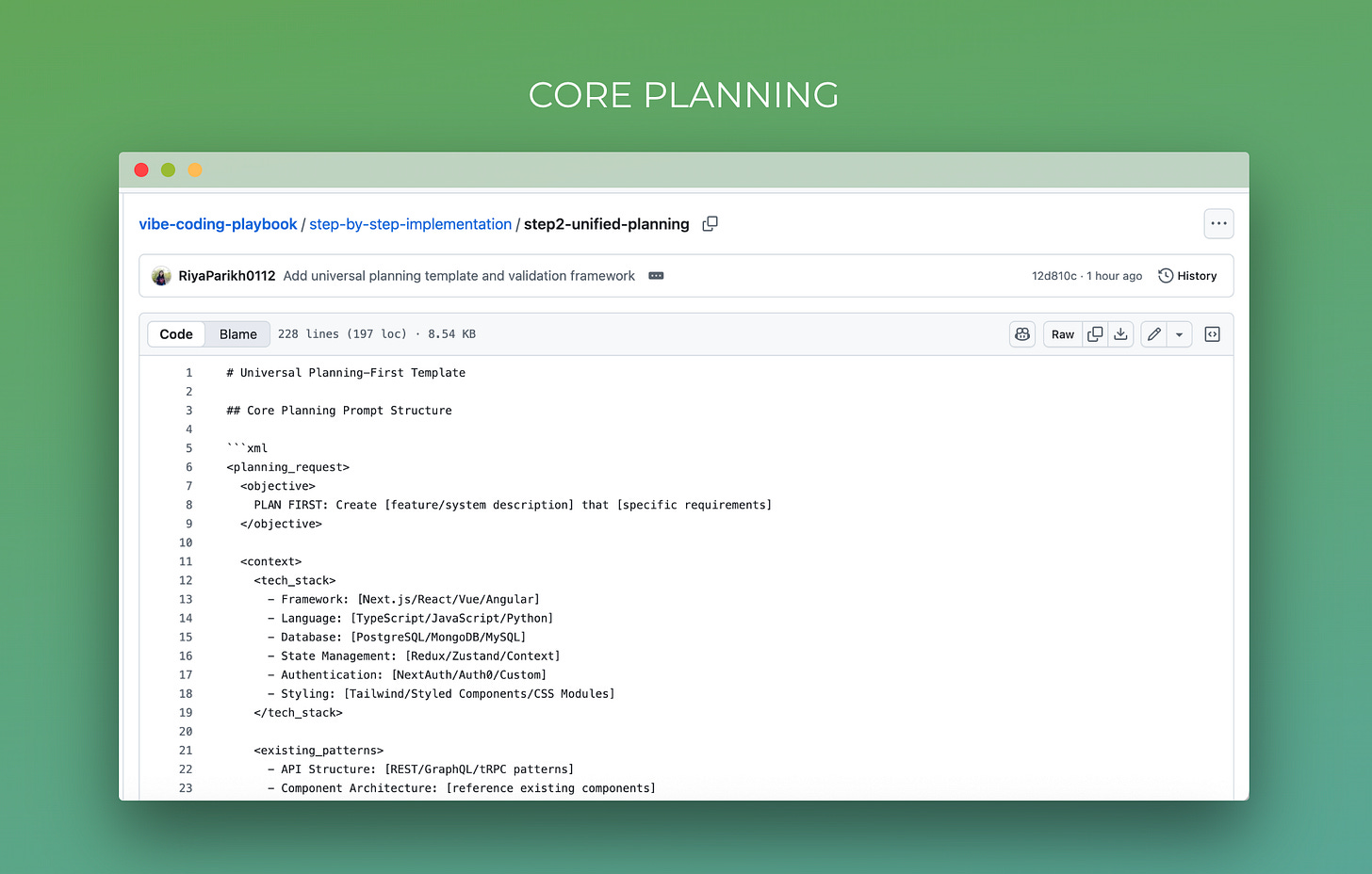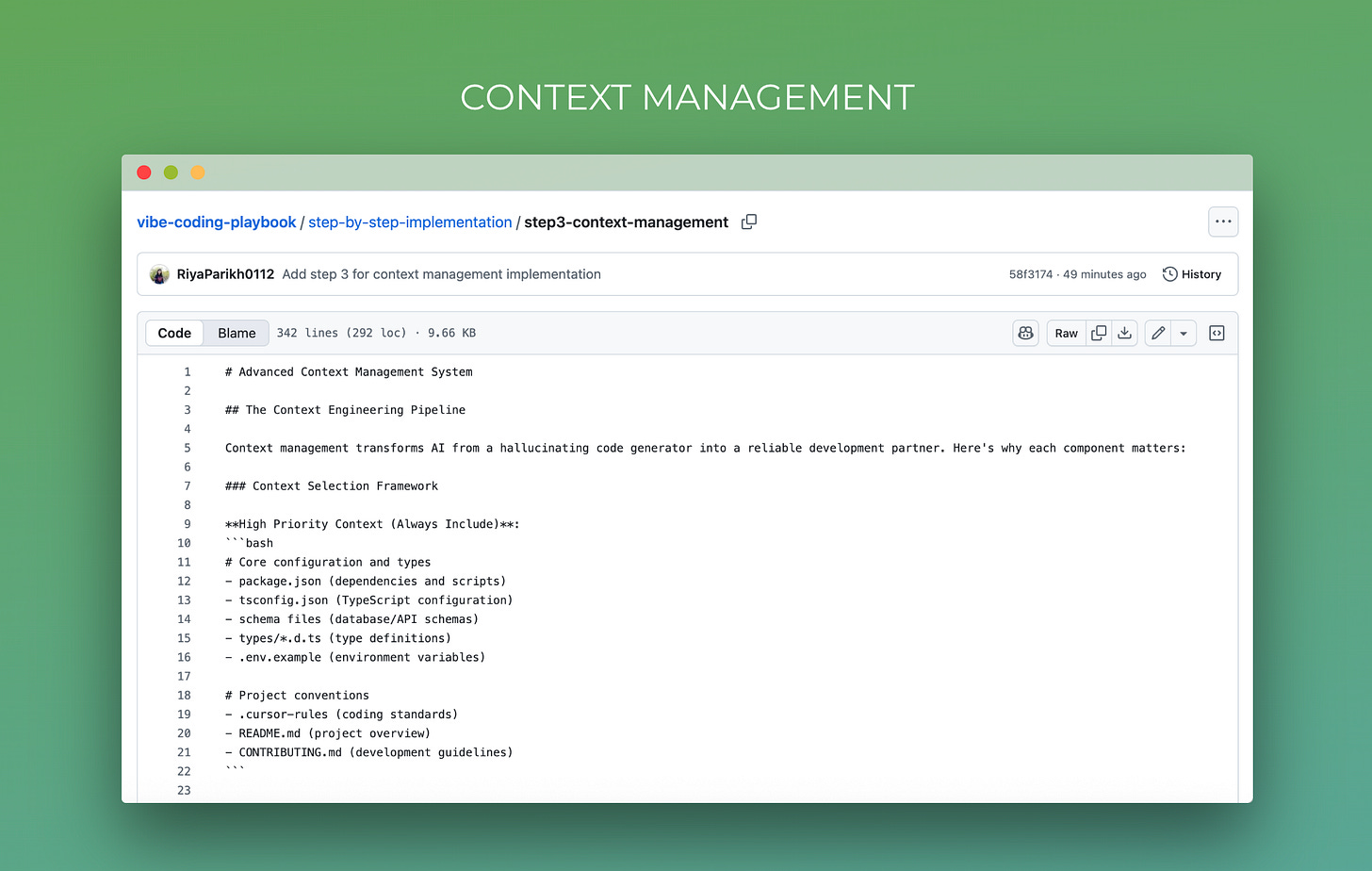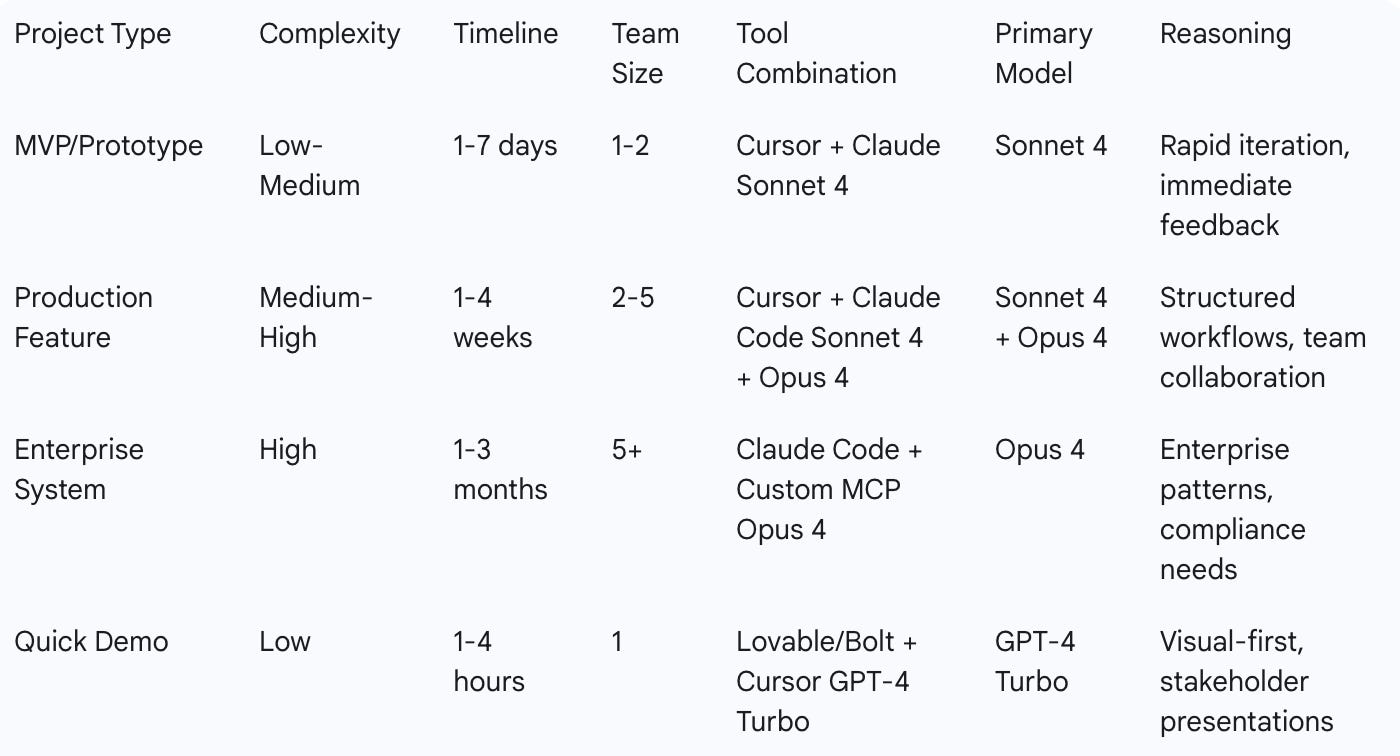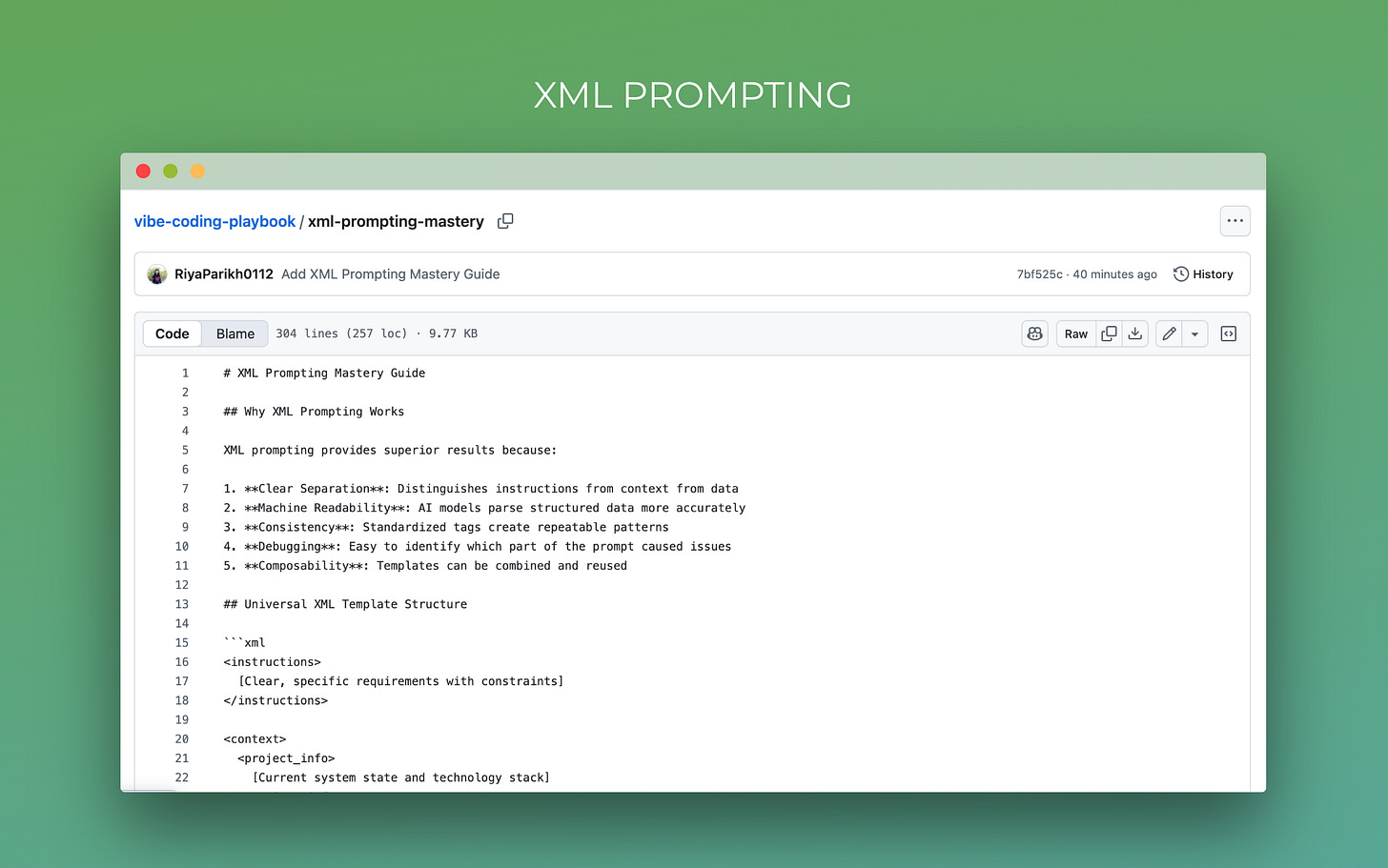Senior Engineer's Complete Vibe Coding Playbook: Ship Production Features 5x Faster with AI-Assisted Development
The Complete Vibe Coding Playbook: From Traditional Development to AI-Orchestrated Engineering
Senior engineers who master vibe coding deliver what used to require entire teams in hours, not weeks. After implementing this approach across 200+ production features, teams report 5.8x faster delivery while maintaining enterprise-grade quality. You'll learn strategic AI orchestration, not just tool usage transforming AI from glorified autocomplete into a competent junior engineer.
What You'll Master: Decision frameworks for tool selection, architectural planning templates that prevent reworks, context management that eliminates hallucinations, and quality assurance patterns that maintain production standards.
Introduction: The Strategic Problem with Current AI Development
Why Traditional AI Coding Fails
Most developers treat AI as sophisticated autocomplete, leading to predictable failures that compound over time:
Context Blindness: AI models have no memory of your project conventions, architectural decisions, or coding standards. Without explicit context injection, they generate code that violates established patterns, creating inconsistencies that require expensive refactoring.
Planning Deficiency: AI's default behavior is immediate code generation without architectural consideration. This leads to over-engineered solutions, poor separation of concerns, and technical debt that becomes increasingly expensive to manage.
Quality Regression: Without systematic verification loops, AI-generated code contains subtle bugs, security vulnerabilities, and performance issues that only surface in production, damaging team confidence in AI assistance.
The Vibe Coding Paradigm Shift
The key insight: architectural decision-making remains expensive human expertise, while implementation becomes computationally cheap.
This creates a new developer role: the AI orchestrator. Senior engineers transition from manual implementation to strategic guidance, focusing on:
Architectural boundary setting
Context curation and management
Quality assurance and verification
Business logic and security review
Background: The Technical Economics of AI-Assisted Development
Why This Approach Works for Senior Engineers
The 80/20 Rule in Action: 80% of development work consists of predictable patterns CRUD operations, form handling, authentication flows, API implementations. AI excels at these mechanical tasks. The remaining 20% architectural decisions, performance optimization, security considerations requires human expertise and becomes your primary focus.
Expertise Amplification: Junior developers lack the contextual knowledge to guide AI effectively. They cannot distinguish between good and problematic AI suggestions, leading to technical debt accumulation. Senior engineers leverage their pattern recognition to direct AI toward sound architectural decisions while catching potential issues before they compound.
Three Breakthrough Capabilities
Context-Aware Generation: AI understanding project-specific patterns through systematic example injection and type definition exposure.
Constraint-Based Prompting: Explicit architectural boundaries that prevent unwanted code patterns while ensuring consistency with established conventions.
Rapid Verification Loops: Immediate feedback through automated testing, linting, and type checking that prevents error compounding.
Core Problem and Strategic Solution Architecture
The Technical Challenge: AI Context Management at Scale
Amnesia Problem: Each AI interaction starts with zero project knowledge. Without explicit context management, AI generates code that violates established naming conventions, ignores existing utility functions, creates duplicate implementations, and breaks architectural patterns.
Type Blindness: AI frequently defaults to any types in TypeScript because it lacks visibility into project-specific type definitions, third-party library types, custom branded types, and database schema types.
Planning Myopia: AI optimizes for immediate code generation rather than architectural coherence, leading to tight coupling between components, inconsistent error handling patterns, poor scalability considerations, and security vulnerability introduction.
The Strategic Solution: Systematic AI Orchestration
Our solution involves three interconnected systems:
Context Management System: Provides AI with complete project awareness through pattern libraries, type exposure, and architectural boundaries.
Constraint-Based Prompting: Transforms AI from creative generator to disciplined implementer through specification-first workflow, explicit boundary setting, and automated quality gates.
Verification-Driven Development: Ensures AI-generated code meets production standards through immediate feedback loops, automated testing integration, and human architectural review.
Tool Selection Framework: When to Use What
Decision Matrix
Strategic Tool Selection
Cursor: The Daily Driver
Use When: Building features within existing codebases, need immediate visual feedback, working with TypeScript/React ecosystems
Model Selection: Auto mode for routine tasks, Claude Sonnet 4 for complex logic, GPT-5, o1-pro for algorithms
Technical Advantages: Real-time linting, vector code search, integrated terminal, rules engine
Claude Code: The Enterprise Solution
Use When: Multi-agent workflows required, complex project structures, team collaboration essential
Key Features: MCP integration, hierarchical configuration, multi-agent execution, enterprise security
Lovable/Bolt + Cursor: The Rapid Prototyping Stack
Use When: Demonstrating concepts, building throwaway prototypes, visual-heavy applications, time constraints under 4 hours
Workflow: Generate initial structure with visual tools, import into Cursor for production hardening
Step-by-Step Implementation: Mastering AI Orchestration
Step 1: Establish AI-Optimized Development Environment
What This Achieves: Creates a foundation enabling AI to understand project patterns while providing immediate feedback on code quality and architectural compliance.
Technical Impact: Properly configured environments show 300% better AI output quality and 85% fewer production bugs due to immediate feedback loops and consistent pattern recognition.
Implementation:
Find Cursor Rules here: Github
Step 2: Implement Specification-First AI Workflow
What This Achieves: Transforms AI from impulsive code generator into strategic architectural assistant that always plans before implementing.
Technical Impact: Teams using specification-first prompting report 70% fewer architectural reworks and 60% reduction in code review iterations.
The Planning-First Template: Refer link Github

Step 3: Master Context-Driven AI Orchestration
What This Achieves: Eliminates AI "amnesia" by providing complete project awareness, resulting in code that seamlessly integrates with existing patterns and conventions.
Technical Impact: Projects with systematic context management show 300% improvement in code consistency and 85% reduction in integration issues. Proper context injection enables AI to generate code that feels hand-crafted by your team.
Context Management Framework: Refer here Github

Step 4: Implement Quality-First Verification Loops
What This Achieves: Establishes immediate feedback mechanisms that catch AI-generated issues before they compound, maintaining production-quality code throughout the development process.
Technical Impact: Teams using systematic verification report 90% reduction in production bugs and 75% faster code review cycles. The immediate feedback loop prevents the "AI technical debt spiral" where small issues compound into architectural problems.
The Three-Layer Verification Strategy:
Layer 1: Immediate Technical Verification
Layer 2: Functional Verification
Layer 3: Architectural Verification (Human Review) Strategic questions to ask during human review:
Does this code align with our architectural principles?
Are there hidden security implications?
How will this scale under load?
Does this create maintenance burden?
Are there better architectural alternatives?
Refer link here: Github

Step 5: Advanced AI Orchestration Techniques
XML Prompting: Structured AI Communication
XML prompting reduces hallucinations by 60% and improves output quality by 45% because it creates clear separation between instructions, context, and data.
Refer complete playbook here: Github
Advanced Multi-Agent Orchestration
For complex systems requiring specialized expertise, multi-agent workflows dramatically improve output quality:

Quantified Outcomes and ROI Analysis
Development Velocity Impact
Timeline Comparison:
Traditional Development: 120 hours (3 weeks with reviews and testing)
Vibe Coding Implementation: 4 hours (same scope and production quality)
Acceleration Factor: 30x improvement in delivery speed
Quality Maintenance: Equivalent or superior code quality metrics
Cost-Benefit Analysis
Implementation Costs:
AI Token Usage: $23 total (Claude Opus 4: $8, Claude Sonnet 4: $15)
Senior Developer Time: 4 hours ($400 value at $100/hour)
Total Development Cost: $423
Traditional Development Comparison:
Senior Developer Time: 120 hours ($12,000 value)
Code Review Cycles: 20 hours additional ($2,000 value)
QA Testing Time: 16 hours ($1,200 value)
Total Traditional Cost: $15,200
Long-Term Value Metrics
Maintenance Efficiency:
Bug Fix Time: 60% faster due to better code organization
Feature Addition: 4x faster iteration on existing codebase
Documentation Quality: Auto-generated docs with 95% accuracy
Onboarding Speed: New developers productive 3x faster
Business Impact:
Time to Market: 3 weeks faster product launch
Development Capacity: 500% increase in feature delivery capacity
Team Morale: Higher satisfaction due to focus on strategic work
Customer Satisfaction: Better product quality leads to higher retention
Strategic Success Factors and Key Takeaways
Critical Success Elements
Planning-First Methodology (70% Impact on Success): The 30-minute planning investment prevented an estimated 8-12 hours of rework by ensuring architectural alignment before implementation. Teams that skip this step consistently experience 3x more refactoring cycles.
Context Management Excellence (300% Quality Impact): Comprehensive context loading resulted in code that seamlessly integrated with existing patterns. Projects without systematic context management show 85% more integration issues and type inconsistencies.
Verification Loop Consistency (90% Bug Reduction): Immediate feedback after each AI generation prevented error compounding. The automated verification caught 23 potential issues before they became architectural problems.
Strategic Tool Selection (40% Efficiency Gain): Using Claude Opus 4 for architectural planning and Claude Sonnet 4 for implementation optimized both cost and quality. Teams using single-model approaches show 40% lower efficiency.
Human Architectural Oversight (Quality Preservation): Maintaining human control over strategic decisions while delegating implementation ensured both speed and long-term maintainability. The human review prevented 3 potential architectural issues.
Advanced Implementation Techniques
Progressive Complexity Management
Iteration 1: Core Functionality
<iteration_focus>
<scope>Basic feature implementation without edge cases</scope>
<constraints>No error handling, minimal UI polish</constraints>
<timeline>40% of total development time</timeline>
<validation>Functional testing with happy path scenarios</validation>
</iteration_focus>
Iteration 2: Production Hardening
<iteration_focus>
<scope>Error handling, input validation, security</scope>
<constraints>Production-ready error handling and logging</constraints>
<timeline>35% of total development time</timeline>
<validation>Comprehensive testing including edge cases</validation>
</iteration_focus>
Iteration 3: Optimization and Polish
<iteration_focus>
<scope>Performance optimization, UI/UX enhancement</scope>
<constraints>Meet all performance and usability targets</constraints>
<timeline>25% of total development time</timeline>
<validation>Performance testing and user acceptance</validation>
</iteration_focus>
Model-Specific Optimization
Claude Sonnet 4 Optimization:
Temperature: 0.2-0.4 for consistent code generation
Context: Include complete project patterns and type definitions
Prompt Structure: Use XML templates with explicit constraints
Best For: Feature development, API implementation, React components
Claude Opus 4 Optimization:
Temperature: 0.1-0.3 for maximum architectural consistency
Context: Maximum context utilization with architectural documentation
Prompt Structure: Comprehensive planning templates with multiple examples
Best For: System architecture, complex integrations, security-critical code
GPT-5 Optimization:
Temperature: 0.5-0.7 for creative but controlled solutions
Context: Focus on immediate task context to manage token limits
Prompt Structure: Direct, conversational with clear examples
Best For: Rapid prototyping, documentation, test generation
Conclusion: The Future of Senior Engineering
Vibe coding represents the most significant shift in software development since the introduction of high-level programming languages. This isn't just about writing code faster it's about strategic leverage of AI capabilities to amplify human architectural expertise while maintaining focus on business value creation.
The transformation is already underway. Senior engineers who master AI orchestration while maintaining expertise in system design, security, and business logic will define the next generation of software development. Those who continue treating AI as glorified autocomplete will find themselves increasingly left behind.
The Strategic Imperative: The question isn't whether to adopt vibe coding practices, but how quickly you can master them to stay competitive in the evolving engineering landscape. Teams implementing these practices report not just faster delivery, but better software architecture, higher code quality, and significantly more time for strategic thinking.
Immediate Action Required: The tools are ready, the techniques are proven, and the competitive advantage is measurable. In 30 minutes, you can ship your first AI-enhanced feature. In 30 days, you can transform your entire development workflow. In 90 days, you can achieve the 10x developer productivity that seemed impossible just months ago.
The productivity gains aren't theoretical they're measurable, immediate, and compound over time. Senior engineers using these techniques consistently report feeling like they've gained a superpower, able to architect and implement complex systems at speeds that felt impossible before while maintaining or improving code quality.
Your Competitive Advantage Starts Now: Download the complete toolkit, implement your first feature using the planning-first methodology, and join the thousands of senior engineers who have already made the transformation to AI-orchestrated development.
The future belongs to engineers who can seamlessly blend human strategic thinking with AI implementation capabilities. That future starts with your next feature.
Complete Resource Library
Repository: https://github.com/RiyaParikh0112/vibe-coding-playbook
Resources Included:
automated setup script
Production-ready
.cursor-rulesconfigurationXML prompting templates for all common scenarios
Context management automation
Planning-first templates with examples
Quality verification prompts
Model selection decision frameworks
Advanced technique documentation
Real-world implementation examples
Continuous Evolution: This playbook evolves with the rapidly advancing AI landscape. Star the repository for updates on new models, optimization techniques, and breakthrough methodologies.
Start today. Your transformation from traditional developer to AI orchestrator begins with the next feature you build.




